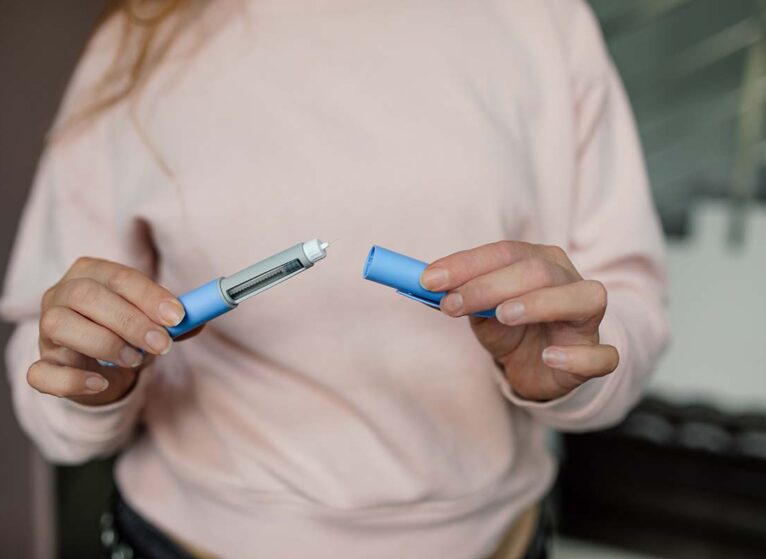For some people, GLP-1 meds can work wonders. They help lower blood sugar (glucose) and manage type 2 diabetes. They also help people with obesity manage their weight. But like many multitasking meds, it's not all sunshine. GLP-1 side effects can come along and spoil the fun.
If a GLP-1 prescription is in your medicine cabinet, you know all about it. GLP-1s affect metabolism, digestion, and appetite. You’re familiar with the benefits, but you could have mild or not-so-mild side effects, too. The more common side effects range from nausea to belly pain and diarrhea.
Fortunately, you have options. You can ward off or manage common complaints. That way, it’ll be easier to stay the course as you pursue healthy treatment goals.
What Is a GLP-1?
GLP-1 might sound like a good name for a robot or an easily hacked password. But in the world of medicine, it’s just a simpler way to say, “glucagon-like peptide-1 receptor agonist.” GLP-1s mimic a natural hormone in your brain and gut. This hormone helps regulate blood sugar, food digestion, and appetite.
GLP-1s trigger hormone-like changes in your digestive tract and brain. Your appetite isn’t as strong. You’ll feel full sooner, leading to weight loss. The type, form, and dose depend on each person’s treatment plan. Most people who take GLP-1 drugs give themselves weekly or daily injections. Many take in 25-50% fewer calories daily.
Which Medicine Is Best for You?
You’ll find many brands of injectable diabetes and weight management meds. To date, there are no generic versions, which are usually more affordable. Ask your insurer about coverage.
Common GLP-1 meds include:
- Semaglutide (Ozempic, Wegovy)
- Tirzepatide (Mounjaro, Zepbound)
- Liraglutide (Saxenda, Victoza)
- Dulaglutide (Trulicity)
When comparing Mounjaro vs. Ozempic or others, consider their active ingredients, costs, and recommended uses.
Semaglutide is the active ingredient in Ozempic and Wegovy. Mounjaro and Zepbound contain tirzepatide. This ingredient is newer and comparative studies are underway. Results vary, but some people report milder side effects with tirzepatide.
New GLP-1 meds are in the pipeline. Your care team can discuss the pros and cons of each for you and your treatment goals.
GLP-1 Side Effects
Trust your gut. You’ll know when it’s time for some changes. Side effects usually involve gastrointestinal (GI) tract or digestive symptoms. Some go away as your body adjusts to treatment.
Your doctor will tell you what to expect, including general and personal risk factors. Certain complications, such as gallstones or pancreatitis (inflamed pancreas), are rare but possible. Seek prompt medical care for any unusual or severe symptoms, such as sharp or intense pain.
More common side effects of GLP-1 meds can include:
- Abdominal discomfort
- Constipation
- Diarrhea
- Dizziness
- Fatigue
- Headaches
- Nausea
- Vomiting
Gut Check: 6 Tips & Tactics to Ease GLP-1 Side Effects
Maybe you’re taking a GLP-1 and are happy with your progress. Still, you’d like a break from bothersome symptoms. Need answers? Try these tips to help settle your stomach and ease side effects.
Looking for Lasting Weight Loss?
It starts with understanding how obesity actually works and unlearning bad advice. Learn the 4 parts of a successful obesity treatment plan.
#1: Watch Your Plate on & Around Shot Days
Whenever you take your GLP-1 shot, be mindful of what and how you eat that day. Be cautious the next few days, too.
Skip dense, greasy, or hard-to-digest foods. Save the thick, juicy steak and Texas fries for another day. Plan fewer, smaller portions, spaced throughout the day. Your stomach will thank you later.
#2: Lighten Up, but Balance Nutrition
Even if you’re not hungry, don’t skip meals or limit nutrition. You’ll still need healthy fats, protein, essential vitamins, and nutrients, and energizing calories. Opt for a salmon salad, your favorite soups, and fresh fruit. Enjoy tasty, nutritionally balanced selections.
#3: Get Fiber & Drink Plenty of Water
When you’re not eating much, you can become dehydrated or constipated. You’ll feel better and be healthier if you sip water throughout the day. Eat apples, celery, veggies, and other good-for-you forms of fiber.
#4: Go Low & Slow
Ask your healthcare provider about starting with a low dose. You can slowly increase the dose so your body adjusts. You can stay at the lower dose longer if you need time to adjust.
Eating low and slow also helps. You can prevent nausea and other symptoms if you don’t overtask your digestive system. Prepare your healthier, smaller portions in advance.
#5: Say No to Trouble-Causers
When you’re feeling queasy, strong smells make things worse. Avoid scented candles or pungent foods. When you eat, turn down the heat. This isn’t a good time to load up on hot Buffalo wings or spicy foods.
Shun rich sauces, fatty foods, and highly processed junk food.
#6: Listen to Your Body’s Clues & Cues
Change isn’t easy! Be good to yourself. Your body will tell you when you need to ease up.
- Stressed? Take a deep breath and relax
- Tired? Rest
- Diabetic? Check your blood sugar
Be patient while your body catches up. Following these tips to manage GLP-1 side effects might take time.
Healthier Days Ahead
GLP-1 meds can play a role as you pursue worthy health goals. But they’re just one part of a larger treatment plan. This includes smart nutrition, exercise, and lifestyle habits. Take medications as directed. Stay in touch with your care team. Check in often. They’re wise guides on your road toward a brighter future.


